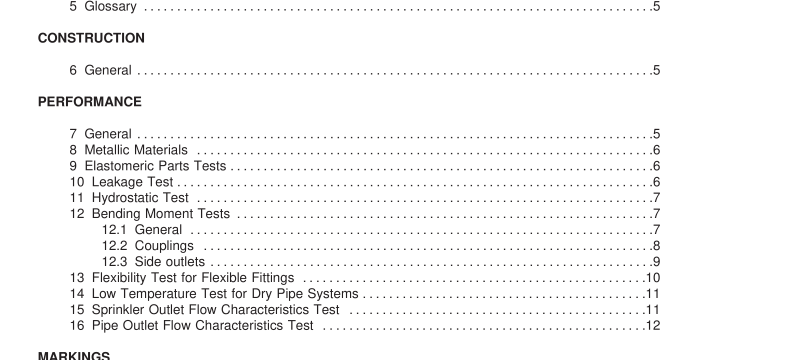UL 213-2009 pdf download.Rubber Gasketed Fittings for Fire-Protection Service.
8 Metallic Materials 8.1 Specimen bars of metals used shall be prepared from the same heat or run of metal used in the fitting samples submitted for investigation and test. The specimen bars shall conform to the minimum physical property requirements of the latest edition of the applicable ASTM or equivalent specification. Samples of bolts shall be tested without special machining. 9 Elastomeric Parts Tests 9.1 An elastomeric part used to provide a seal shall have the following properties when tested as specified in the Standard for Gaskets and Seals, UL 1 57: a) For silicone rubber (having poly-organo-siloxane as its constituent characteristic), a minimum tensile strength of 500 psi (3.4 MPa) and a minimum ultimate elongation of 1 00 percent. b) For natural rubber and synthetic rubber other than silicone rubber, a minimum tensile strength of 1 500 psi (1 0.3 MPa) and minimum ultimate elongation of 1 50 percent; or a minimum tensile strength of 2200 psi (1 5.2 MPa) and a minimum ultimate elongation of 1 00 percent. c) Those properties relating to maximum tensile set; minimum tensile strength and elongation after oven aging; and hardness after oven aging, all as specified in UL 1 57. The maximum service temperature used to determine the oven time and temperature for oven aging is 60°C (1 40°F). 9.2 The Standard for Gaskets and Seals, UL 1 57, provides for the testing of either finished elastomeric parts or sheet or slab material. Sheet or slab material is to be tested when the elastomeric parts are O-rings having diameters of less than 1 inch (25.4 mm). The material tested is to be the same as that used in the product, regardless of whether finished elastomeric parts or sheet or slab material is tested. 10 Leakage Test 1 0.1 A rubber gasketed fitting assembly with pipe shall withstand for 1 minute, without leakage, an internal hydrostatic pressure of two times its rated pressure. No leakage of the fitting shall occur as the pressure is increased to the test pressure.
13 Flexibility Test for Flexible Fittings 1 3.1 A flexible fitting shall provide for angular movement and axial displacement as described in 5.3 without leakage or pipe damage when tested in accordance with 1 3.2 and 1 3.3. 1 3.2 The pipe ends to be joined are to be prepared in accordance with the fitting manufacturer’s specifications. The pipes are to be joined by the fitting with the pipe ends touching or as close as the fitting permits. A line is to be scribed 1 inch (25.4 mm) from each pipe end. The distance between the two scribed lines is to be measured. The assembly is to be filled with water and pressurized to the rated pressure specified by the manufacturer. The distance between the lines is to be measured, and the difference between the two measurements is the measured axial movement. 1 3.3 With the assembly pressurized to its rated pressure, a bending moment is to be applied to deflect the joint to the maximum angle specified by the manufacturer, while not less than 1 degree for nominal pipe diameters less than 8 inches (203.2 mm) or 0.5 degrees for 8 inches (203.2 mm) and larger. The bending moment applied is not to exceed 25 percent of the bending moment specified in Table 1 2.1 or 1 2.1 .2 whichever is applicable. The angle is to be measured using an inclinometer, or equivalent, or by measuring the deflection and distance between the support points and calculating the angle. Observations are to be made for leakage or pipe damage.
14 Low Temperature Test for Dry Pipe Systems 1 4.1 Two sections of pipe, each a minimum of 4 inches (1 02 mm) long, are to be assembled onto a sample coupling, and their open ends fitted with end caps. One end cap is to be provided with threaded holes for attachment to an aerostatic pressure source and a pressure gauge. See Figure 1 4.1 . With the assembly lying on its side, 1 /8 inch (3.2 mm) of water is to be introduced into the assembly, and the assembly is then to be sealed and gradually pressurized with air to a pressure of 40 psig (276 kPa). The pressurized assembly is then to be placed in air maintained at a temperature of minus 40°F (minus 40°C) for a period of 24 hours. Following the 24-hour low temperature exposure, the assembly is to be placed in room ambient temperature of 73 ±5°F (23 ±3°C) for an additional 24-hour period. Following the 24-hour exposure to room ambient temperature, there shall be no decrease in the pressure in the assembly from the pressure measured before the low temperature exposure.UL 213-2009 pdf download.
UL 213-2009 pdf download
